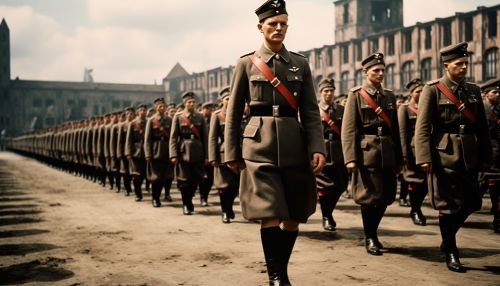6th Army (Wehrmacht)
Formation and Early Campaigns
The 6th Army was a field army unit of the German Wehrmacht during World War II. Formed in October 1939, it was initially commanded by General Walther von Reichenau. The 6th Army is best known for its role in the Battle of Stalingrad, where it was encircled and destroyed by Soviet forces in 1942-43.


The 6th Army was first deployed in the Invasion of Poland in 1939, where it was part of Army Group South under the command of General Gerd von Rundstedt. Following the successful conclusion of this campaign, the 6th Army was relocated to the Western Front in preparation for the Battle of France in 1940. Here, it played a key role in the breakthrough at Sedan, which led to the encirclement and defeat of the Allied forces in Belgium.
Operation Barbarossa
In 1941, the 6th Army was redeployed to the Eastern Front for Operation Barbarossa, the German invasion of the Soviet Union. It was part of Army Group South, and its initial objectives were to capture the important industrial city of Kharkov and to secure the southern flank of the German advance towards Moscow. The 6th Army achieved a number of significant victories during this phase of the war, including the capture of Kharkov in October 1941.
Battle of Stalingrad
The 6th Army's most famous and tragic campaign was the Battle of Stalingrad. In 1942, it was given the task of capturing the city of Stalingrad on the Volga River. The battle began in August 1942 and initially the 6th Army made significant progress. However, the Soviet resistance stiffened and by November, the 6th Army was bogged down in brutal urban warfare.
In November 1942, the Soviet Red Army launched Operation Uranus, a major counter-offensive that succeeded in encircling the 6th Army in Stalingrad. Despite desperate attempts to break out or to be resupplied by air, the 6th Army was gradually worn down by the harsh winter conditions and constant Soviet attacks. By February 1943, the remnants of the 6th Army, now under the command of General Friedrich Paulus, were forced to surrender. The Battle of Stalingrad was a turning point in World War II and marked the beginning of the end for the Third Reich.
After Stalingrad
Following the destruction of the original 6th Army at Stalingrad, a new 6th Army was formed in March 1943. This new army fought on the Eastern Front until the end of the war, participating in battles such as the Battle of Kursk and the defensive battles in Hungary and Austria in 1944-45. However, it never achieved the fame or notoriety of the original 6th Army and its doomed campaign in Stalingrad.
Legacy
The 6th Army's campaign in Stalingrad has been extensively studied by military historians and is often cited as an example of the dangers of hubris and strategic overreach. The 6th Army's encirclement and destruction marked a turning point in World War II and is seen as one of the key moments in the defeat of Nazi Germany.
